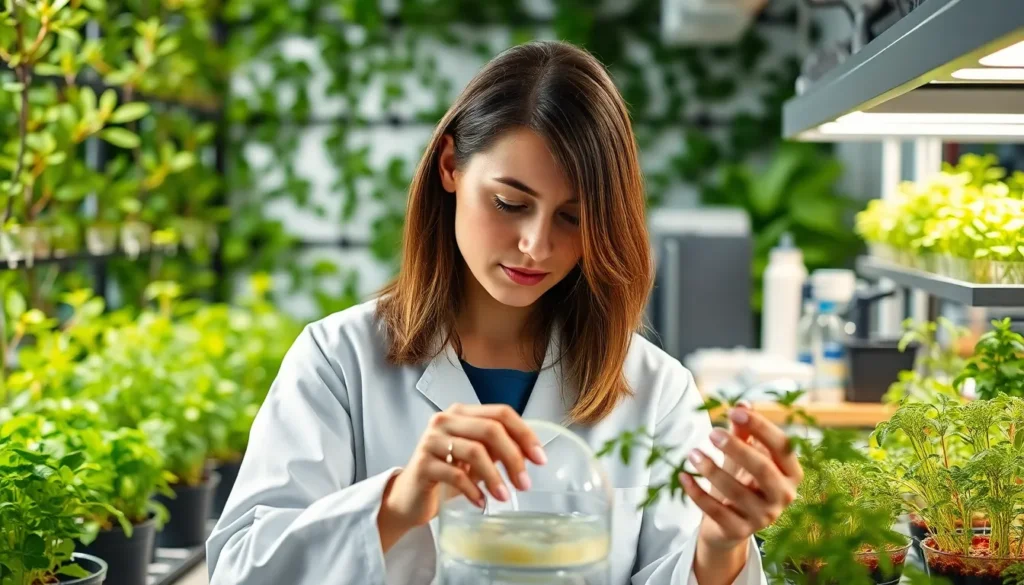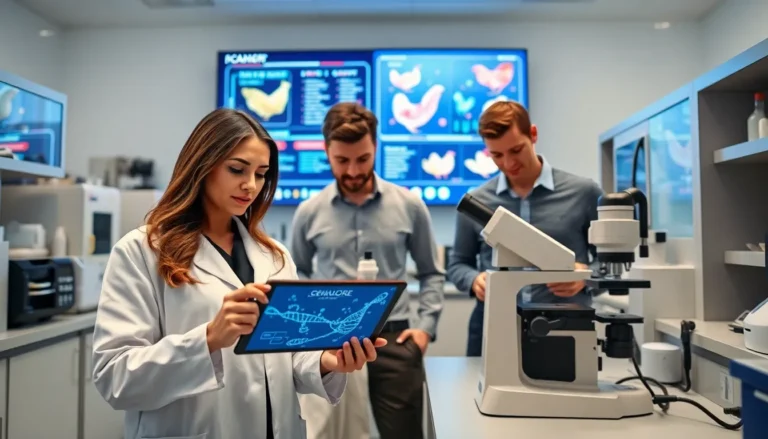In a world where climate change feels like that uninvited guest who just won’t leave, environmental biotech emerges as the superhero we didn’t know we needed. Picture this: tiny microbes and genetically engineered plants teaming up to tackle pollution and restore ecosystems. It’s like a sci-fi movie, but with fewer explosions and more eco-friendly solutions.
Table of Contents
ToggleOverview of Environmental Biotech
Environmental biotechnology employs biological processes to address ecological issues. It utilizes microorganisms, plants, and enzymes to promote sustainability and restore ecosystems. Breakthroughs in gene editing, particularly CRISPR technology, enhance the capabilities of organisms to tackle pollution.
Microbes play a pivotal role in bioremediation, a process that cleans contaminated sites. Specific bacteria degrade harmful compounds in soil and water, making restoration efficient and effective. For instance, Pseudomonas species can metabolize oil spills, reducing environmental damage significantly.
Moreover, genetically engineered plants enhance phytoremediation, whereby plants absorb and detoxify pollutants from soil. Sunflowers and willows, for example, thrive in contaminated areas and remove heavy metals. Such plants offer a cost-effective, natural solution to soil restoration.
Innovative waste treatment methods also emerge from environmental biotech. Biofilters, harnessing bacteria, treat wastewater and air by breaking down organic matter. These systems reduce pollutants while recycling nutrients, promoting a circular economy.
Additionally, bioplastics represent a sustainable alternative to traditional plastics. Derived from renewable resources, these materials minimize environmental impact and decomposition time. Their increasing adoption results from the need for greener products in numerous industries.
Environmental biotechnology encompasses diverse processes and applications that drive sustainability. It fosters innovative solutions to combat pollution and restore ecosystems, highlighting the vital role of science in addressing climate change challenges.
Key Technologies in Environmental Biotech

Environmental biotechnology leverages biological processes to create sustainable solutions for ecological challenges. Key technologies in this field include bioremediation techniques and wastewater treatment innovations.
Bioremediation Techniques
Bioremediation employs microorganisms to remove pollutants from the environment. Effective bacteria, such as Pseudomonas species, break down toxic compounds in contaminated soil and water. Phytoremediation uses plants like sunflowers and willows to absorb and detoxify harmful substances. These plants thrive in polluted areas, making them invaluable for restoration efforts. Various approaches enhance bioremediation, including bioaugmentation, where specific microbes are added to contaminated sites to boost degradation processes. Environmental biotech focuses on maximizing efficiency and effectiveness in treatment methods, ultimately leading to healthier ecosystems.
Wastewater Treatment Innovations
Innovative technologies in wastewater treatment harness the power of bacteria to purify water. Biofilters represent a major advancement, using microbial communities to break down organic matter and contaminants in wastewater. Constructed wetlands utilize natural processes, allowing plants and soil organisms to clean water effectively. These systems promote ecological balance while treating waste. Membrane bioreactors integrate biofiltration with membrane separation, improving treatment efficiency. The adoption of these cutting-edge technologies supports circular economy principles, reducing environmental impact while ensuring clean water availability.
Applications of Environmental Biotech
Environmental biotechnology significantly impacts various sectors, promoting sustainability and ecological health. Key applications include soil restoration and pollution management, both of which address critical environmental challenges.
Soil Restoration
Soil restoration involves utilizing microorganisms and plants to rejuvenate degraded lands. Specific bacteria, like those from the genus Rhizobium, enhance soil fertility by fixing nitrogen, which benefits crops. Mycorrhizal fungi improve nutrient uptake in plants, helping restore biodiversity. Phytoremediation techniques use deep-rooted plants such as sunflowers to extract heavy metals from contaminated soils. Engineers and scientists develop biofertilizers to accelerate soil recovery, ensuring healthier ecosystems. Implementing these approaches supports agriculture while increasing soil resilience against erosion and climate variability.
Pollution Management
Pollution management relies heavily on the power of bioremediation and innovative treatment methods. Microorganisms, especially certain Pseudomonas species, break down toxic compounds in water and soil, effectively detoxifying hazardous waste. Advanced techniques like biofilters utilize bacterial communities to treat wastewater, effectively reducing contaminants. Constructed wetlands replicate natural ecosystems to purify water, supporting diverse wildlife. Integrating these technologies fosters a cleaner environment while promoting sustainable resource use. Continuous research and development enhance these methods, allowing for more efficient solutions to pollution issues.
Challenges Facing Environmental Biotech
Environmental biotech encounters several challenges that can hinder its growth and effectiveness. These challenges include regulatory hurdles and public perception issues that shape its acceptance and implementation.
Regulatory Hurdles
Regulatory frameworks often lag behind technological advancements in environmental biotech. These frameworks can create bottlenecks that delay the approval of new biotechnological solutions. Compliance with environmental safety standards also requires extensive testing and documentation, consuming valuable resources. Agencies may impose strict regulations on genetically modified organisms. The complexity of these regulations can discourage innovation and slow down the deployment of beneficial biotechnologies. Moreover, inconsistencies across regions can complicate market access, impacting the scalability of successful solutions.
Public Perception and Acceptance
Public perception significantly influences the acceptance of environmental biotech solutions. Misinformation about genetically engineered organisms can lead to skepticism and resistance among communities. Trust in scientific advancements plays a crucial role in this context, as individuals often seek assurance regarding safety and environmental impact. Educational initiatives can foster understanding and support for innovative solutions. Industry stakeholders must engage transparently with the public to address concerns and highlight benefits. Additionally, initiatives that showcase successful applications of environmental biotech can positively shift public views and cultivate broader acceptance.
Future Trends in Environmental Biotech
Significant advancements in environmental biotechnology shape its future landscape. Gene editing technologies, particularly CRISPR, push boundaries by enhancing organisms’ abilities to remediate contaminated environments. Innovative tools improve microbial efficiency in bioremediation, allowing specific bacteria to thrive in harsher conditions.
In addition to genetic advancements, researchers focus on sustainable practices in agriculture. Biofortified crops become more prevalent, as they require fewer resources while delivering essential nutrients. Drones now monitor plant health and soil conditions, ensuring optimal growth environments.
Wastewater treatment technologies evolve rapidly, incorporating biofilters and constructed wetlands. These methods leverage microbial communities to efficiently purify water while minimizing energy consumption. As populations grow, the demand for efficient waste management solutions increases.
Climate change remains a central driver for developing new biotechnological approaches. Circular economy strategies motivate the creation of biodegradable plastics from renewable resources. Industries pursue collaboration with biotechnologists to develop eco-friendly products, aligning with sustainable business practices.
Emerging technologies also address air pollution challenges. Innovations utilize microorganisms capable of degrading harmful compounds in the atmosphere. Strategies targeting emissions from industrial sources lead to cleaner urban environments.
Public engagement plays a vital role in shaping environmental biotechnology’s future. Educating communities about benefits enhances acceptance of biotechnological solutions. As transparency increases, skepticism surrounding these technologies diminishes.
Regulatory frameworks must adapt to keep pace with innovations. Streamlined approval processes can facilitate quicker access to market, allowing beneficial solutions to reach those in need. Collaboration between scientists, regulators, and the public fosters a proactive approach to environmental challenges.
Environmental biotechnology stands at the forefront of innovative solutions to pressing ecological challenges. By harnessing the power of microbes and genetically engineered plants, it offers effective strategies for pollution management and ecosystem restoration. As advancements in gene editing and sustainable practices continue to emerge, the potential for these technologies to transform environmental health becomes increasingly evident.
However, addressing regulatory hurdles and public skepticism remains crucial for widespread adoption. Engaging the public through education and transparent communication will be key to fostering support for these groundbreaking solutions. With a collective effort, environmental biotechnology can pave the way toward a more sustainable future.










